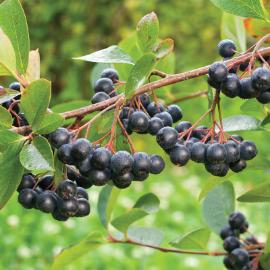BACKGROUND: Products derived from black chokeberry are claimed to be beneficial in treating chronic diseases, such as obesity and diabetes. Karjalainen, R. Stability of anthocyanins in berry juices stored at different temperatures.
However, a recent study by Qin and Anderson 11 showed that animals fed a high-fructose diet supplemented with chokeberry extract in the drinking water for five weeks had increased PPARγ expression in epididymal fat. Adiponectin is the most abundant peptide secreted by adipocytes and is a key hormone in the inter-relationship between adiposity, insulin resistance and inflammation 22 Circulating adiponectin levels are inversely related to body fat percentage 23 Adiponectin increases the sensitivity to insulin through activating AMP kinase, promoting glucose uptake by muscles via intracellular translocation of the GLUT4 transporters and by reducing gluconeogenesis by inhibiting the hepatic enzyme phosphoenolpyruvate carboxylase, which inhibits the synthesis of fatty acids and stimulates their oxidation 22 Our data support results from an earlier study, which demonstrates that chokeberry extract elevated plasma adiponectin in rats fed a high-fructose diet when compared with the controlgroup 11. The concentrations of individual anthocyanins and procyanidins and total flavonols and hydroxycinnamic acids in Aronia juice concentrate (AJC) are shown in Table 2 The composition of anthocyanins (expressed as single strength juice (957.2 ( Table 2 )/5.4)) is similar to previous reports 7, 17 The content of total anthocyanins (177 mg/mL) in AJ was similar to the value of 169 mg/100 mL previously reported for AJ prepared from AJC 17.
Aronia Fruit Popsicle
1 cup frozen aronia berries, sliced in half. Add aronia berries & nuts and chop briefly. Just add them to any juice, fruit popsicle, or your favorite yogurt. For my other Aronia Berry recipes check out the links below Aronia berries look very similar to blue berries and generally said, any recipe containing blueberries can be made with aronia berries as well.
The Aronia Berry Jam
You will need oat and rice flour for the crust and for the filling aronia berries and apples. This one is a simple and quick recipe to use aronia berries.
You will have to cook the berries with apple cider vinegar, sugar, cinnamon and orange zest. To prepare these healthy, homemade popsicles you will need Greek yogurt, honey and of course aronia berries. The aronia berries make the muffins rich in antioxidants, giving a slightly sour and deliciously juicy flavor to them.
Aronia berry or also called choke berry, is becoming more and more popular due to its extraordinary health benefits. A deep, red bottle of aronia berry wine is sure to be a memorable Christmas gift to anyone lucky enough to receive one. Adding half a pint of red grape concentrate is preferable to some, but I like to let the aronia berries shine.
The Aronia Berry Wine
The same basic equipment used to make grape wine can be used for aronia berries. The aronia berry wine is simple and uses the same equipment and basic knowledge discussed in my previous article Foraging and Fermenting Wild American Grapes,” which can be found in the August 2016 issue of Omaha Magazine online.
We come from many states and Canada, sharing knowledge and experience with other growers, processors and those with interest in the Aronia berry. Other uses include winemaking, tea, syrup, salsa, spreads and as natural food. Berries are juicy with an astringent dry taste.
Black chokeberry, is a deciduous shrub native to North America and is often. Aronia berry…the powerpacked superfruit of superfruits! The Midwest Aronia Association (MAA) has published the first edition of the Aronia Berry Recipe book!
Aronia berry syrup can be processed in sealed jars, but I just keep my syrup in the refrigerator or freezer. Add egg and mix for just a few seconds until mixture is no longer dry.
Aronia berries have natural pectin that adds body to the filling as it cooks.
Becky's French Apple & Aronia Berry Pie
Aronia berries are folded into the apple pie filling just before it all goes into the crust.
Aronia berry syrup is such a beautiful color. Aronia berries were not something we found when I was growing up on the farm but they are native and it is likely they were in the woods a few generations ago since they grew wild in many parts of the country.

